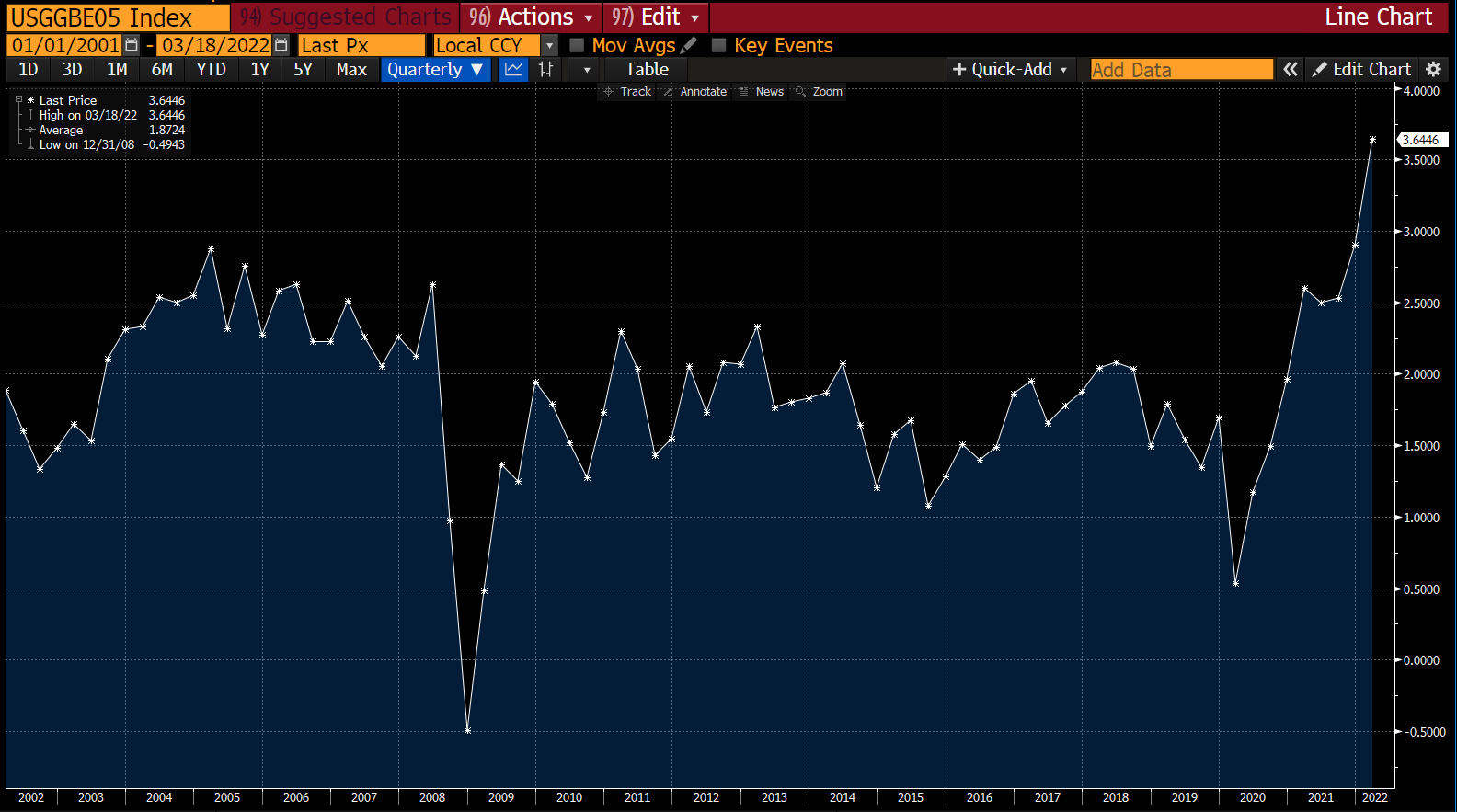2022 Theme: US Recession Risk Rises, How To Think About It?
Optimism around peace in Ukraine and China's government changing tack was likely not the only thing helping buoy markets this week. The Fed, as always, had a big role to play as well.
After endless gnashing of teeth and months of "will they/won't they" we have finally had our first US interest rate hike of this cycle.
It is A LOT of bother for a meager 0.25% hike. As a reminder this is where we are with the federal funds rate that the Fed has just hiked versus current inflation:
The last time inflation was here the Fed Funds rate was 13%.
Hard not to feel underwhelmed.....
Still, now that we have finally begun our hiking cycle, the financial commentariat is, as they are wont to do, scurrying after a new theme:
Namely, an economic recession.
Goldman Sachs is not alone here but the bank received a lot of attention when it lowered its expectations for US economic growth for the second time this year and also said that there could be a 35% chance of a recession in 2023.
That seems premature. It is hard not to look at the latest string of job numbers (very good), the unemployment rate (very low) or the slowly departing pandemic (thank you modern pharmaceutical science) and think:
All we need to do is achieve a swift conclusion of hostilities in Ukraine and bring inflation under control and we could be on easy street baby!
Those tasks may seem daunting but inflation and even wars do not necessarily predict recessions with any high degree of confidence.
There are some signs that do. Typically, there are three markers that frequently signal a recession.
They are:
A commodity price shock.
An inverted US yield curve.
The Federal Reserve tightening financial conditions.
And regrettably as regular readers of this newsletter will know we are already looking at two of the three.
As we have covered in some depth, not just energy but many other commodities besides are seeing double digit gains for the second year in a row. These can hurt economic growth by hurting consumers' ability to spend and also crimping business profit margins.
An inverted US yield curve is a process where short term interest rates are higher than long term rates. So, the 2 year US bond's yield or rate is above that of a US 10 year bond interest rate. We are very close to this (see chart below) but not quite there yet.
As of this week, the Federal Reserve is now formally hiking US interest rates and conditions are tightening.
Here is the US yield curve chart. The curve is clearly "flattening" which suggests investors are worried about economic growth over the medium to long term:
It is not quite inverted yet but it is getting perilously close. The above pink zones are previous recessions and so you can see why people would make this association.
So, add this you can see where Goldman Sachs is coming from:
Financial conditions are tightening, commodities are high (oil dropped below but then swiftly rose back above $100 this week) and investors are putting cold hard cash
It may not be a certainty but many of the classic signs are already there and as this newsletter has stressed, the probability of a Fed mistake or a sudden growth shock, is now non trivial.
But is there not a solution to the above risks?
Couldn't you just let inflation run a bit hotter than you should? Wouldn't that avoid many of the problems.
One of the most painful aspects of the current economy is that people feel awful despite record employment and rising wages. Here is a chart we have shown before from the Michigan survey of Consumer Sentiment:
It has reached lows not seen since the financial crisis.
But those feelings needn't necessarily become reality. The economy is still growing very strongly. There are many well paying jobs available and, in many industries, more work than there is labor or supply to complete it.
This is pretty good.
As long as wages can hopefully keep up then it will be manageable. That may be a big "if" but even a slowly eroding standard of living is likely preferable to a recession and spiking unemployment.
Even before the Ukraine war we found the idea of very aggressive rate hikes from the Federal Reserve to be difficult to imagine. In January there were calls for 7, even 9 interest rate hikes this year and, in many cases, a double rate hike (0.50% rather than 0.25%) for this March meeting.
Well that didn't happen and we highly doubt that the higher end of interest rate hike estimates will occur either.
We might not be alone. Here is a chart of where traders and investors are thinking inflation will be in 5 years. Even after the Fed has begun to rise rates they are sending the expected rate of inflation higher in 5 years time:
Maybe Chairman Powell and the Federal Reserve Committee have come around to the simple fact that raising interest rates won't solve supply chain issues nor will they help with global grain prices or energy costs.
There are limits to what the central bank - even one as mighty as the Fed - can achieve. And "just doing something" might break the first rule of being a good economic physician: first do no (economic) harm.
Anything beats a recession.....
*******
Have questions? Care to find out more? Feel free to reach out at contact@pebble.finance or join our Slack community to meet more like-minded individuals and see what we are talking about today. All are welcome.




